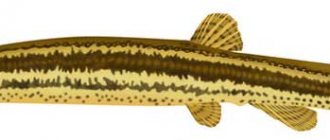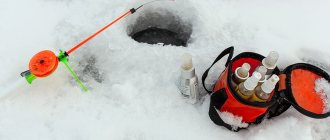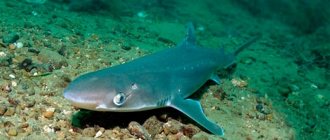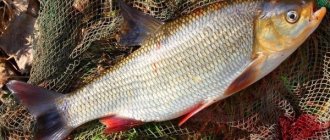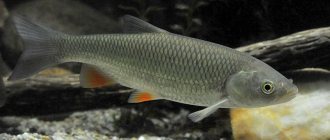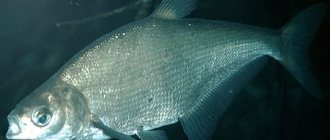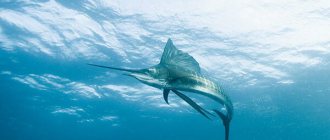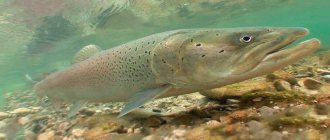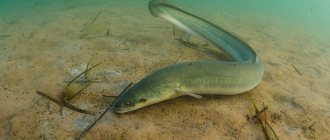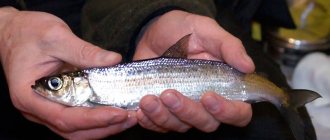Description
The body of the ruff is noticeably flattened on the sides. The large head (relative to the length of the body) has bulging eyes in its upper part. The iris of the eyes has a bluish tint. The small retractable mouth contains small bristle-like teeth. On the body of the ruffe there is a fused dorsal fin with sharp spines. In the front it is noticeably higher. Small scales fit tightly to the body.
The color of the ruffe. A characteristic feature is the dark back with a greenish tint. Chaotically located brown spots are clearly visible on the sides. The sides have yellowish tints. Gray tones predominate on the belly. There are dark spots on the membranes of the dorsal and caudal fin. The color of the ruffe depends on the living conditions. In reservoirs with a sandy bottom, the color of the fish is lighter, and darker in areas with a silty bottom.
The common ruffe grows up to 12 cm and gains weight up to 30 g. Towards the east, larger individuals are found. For example, in the reservoirs of the Urals, ruffs 15-18 cm long and weighing up to 100 g are often caught on a hook. In the lower reaches of the Ob, no one is surprised by a ruff that has grown to 25 cm and weighs about 200 g.
Maximum lifespan: for males – 7 years; in females - 11 years. The populations are dominated by individuals aged 2-3 years.
Reproduction and lifespan
With the onset of spring, the ruffe begins to prepare for spawning. This process usually affects ruffs at the age of 2-3 years. In a particular population, due to external conditions, the lifespan of most individuals may become short-lived. In this case, one-year-old ruffes will participate in spawning.
Ruffs, like some other fish, may have hermaphroditism. That is, the same ruff has both female and male reproductive organs. This deviation is not observed in all populations and in no more than 25% of ruffes in a flock. It develops as a compensation mechanism for increased mortality of fish of either sex.
There is no clear dependence of the spawning process on water temperature, light or other conditions. In early spring, a flock of ruffs emerges from the depressions in which they overwintered. The spots on the bodies of male ruffed ruffs become brighter and more contrasting.
The flock moves to areas where the water is sufficiently rich in oxygen. The process of spawning may not be a one-time process. The female can lay clutches 2-3 times. The males accompanying the females water the eggs with milk. Spawning lasts from 3 days to 2 weeks.
The ruffe egg is small - from 0.3 to 1 mm. If she is lucky and she is fertilized, after 1-2 weeks a larva will appear, which will quickly develop into a ruff fry. Adult fish do not care about the eggs or the young that emerge from them.
During spawning, 1-2 weeks, the ruffe stops feeding. This is probably a natural mechanism to protect the eggs from their own parents. In addition, the species is protected from all predators by the mass production of offspring.
The female, depending on her size, lays from ten to several hundred thousand eggs. The survival rate of eggs, larvae, and fry is low. But ruffes that have escaped predators, fishermen and disease can live up to 10 - 12 years. This is the limit for females; males live less, up to 7 - 8 years.
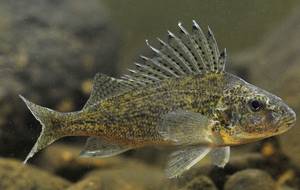
Nutrition
The basis of nutrition for the fry, after hatching and reaching a height of up to 1 cm, is made up of rotifers (protostomes). As they grow older, their diet is replenished with chironomid larvae and cladocerans.
Nutrition for an adult ruff:
- Crustaceans;
- Water worms;
- Leeches;
- Caviar and fry of other fish species.
In daylight, the fish's visual organs are used to search for food, and the lateral line plays an important role in determining the location of stationary food.
Common ruff fish.
The common ruffe is a well-known small freshwater fish, one of four species of the genus of ruffes, the perch family.
The needle-like spines on the fins and gill covers of the ruffe will not allow it to be confused with any other fish. Especially when a handsome man taken out of the water spreads his fins and puffs out his cheeks, demonstrating the full power of his pointed arsenal, and also twists his tail strongly, taking a threatening stance. The prickly spines on the body and the bristly nature of this small fish served as the motive for calling it a ruff.
- Do you want to go fishing, but don’t know where to start, what gear to choose, where and how to fish?
The e-book “Fishing for Beginners” will answer all your questions and will be the best assistant in mastering this activity. More details
Types of fish of the genus ruffes
The family of perch fish also includes other species of fish of the ruff genus:
Don ruff. Other names for the Don ruff: nosar, beaver; privet. It differs from a regular ruff in its wedge-shaped head with an elongated front part. Lives only in clean waters. Avoid areas with cold water. It feeds mainly at night. It is very rarely found in reservoirs together with the common ruffe. It can grow up to 20 cm and gain a weight of 200 grams.
Czech ruff (Balona ruff). Characteristic differences from the ordinary ruff: shorter and taller body; massive and small head (relative to body length); The color is dominated by gray-brown shades, and on the sides there are dark spots that look like intermittent transverse stripes. Dark spots also appear on the gill covers.
Striped ruff. It differs from other species of ruffes by three or four longitudinal stripes from the head to the caudal fin.
In favorable conditions it can grow up to 30 cm and gain weight up to 250 g. The striped ruff is rarely found in domestic reservoirs.
Characteristics and varieties
There are 4 types of ruffs:
- ordinary;
- Donskoy lives in the Kuban rivers, the Black and Azov Seas, and the Taganrog Bay;
- tabby has dark stripes on the sides;
- The Czech Ballona ruff is listed in the Red Book of Ukraine as an endangered species.
Fishing for ruffe
More often, targeted fishing for ruffe is carried out to replenish the arsenal of baits with live bait. When fishing from ice, burbot bites well on ruffe, and in open water, pike, large perch and other predatory fish.
At the same time, a ruff caught on a hook when fishing for crucian carp is usually thrown away. And this is in vain. Ruff soup has an excellent taste, and it can be prepared on a pond during long-term (a day or more) fishing.
Lifestyle and habitat
It is difficult to imagine a body of water in central Europe where the ruffe could not get along - it is an opportunistic fish. Siberian rivers and lakes have been completely mastered by him up to the Kolyma basin. Moreover, the ruffe is not bothered by the low salinity of the water - up to 12 ‰.
The ruffe especially loves sluggish rivers and deep lakes with a soft, clayey substrate at the bottom. The coastal vegetation suits the ruffe. He favors shaded areas of the reservoir. In such places, it is easier for the ruff to use its advantage: it sees well in low light.
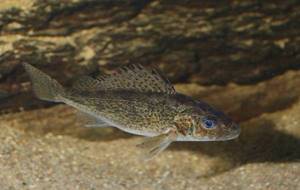
The biological balance in places where the ruffe lives may be disrupted.
If there is no pressure on the ruffe from predatory fish, it begins to multiply quickly. Ruffs of all ages rely heavily on fish eggs in their diet. By devouring it, populations of valuable fish species can be reduced to zero.
Fishing for ruffe in open water
To catch ruffe in open water, use a float rod or elastic tackle. It is important to correctly determine the fishing location. Ruff avoids open areas of the reservoir and fast currents. You need to look for ruffe in the coastal zone with bushes and trees hanging over the water. An excellent sign of the presence of ruffe are islands of reeds at a distance from the shore, behind which a reverse current is observed.
The ruff does not rise to the surface, but does not live at the bottom either. Gear should be equipped with the ability to fish horizons from the bottom surface to mid-water. A rig with several hooks is used. The leashes are tied at a distance of 20-30 cm. Ruff pays little attention to the bulkiness of the gear. It is better to install a fishing line of 0.18-0.20 mm. Reinsurance against being bitten by larger fish will not be superfluous.
Where do ruffs live?
If we talk about the distribution area, the ruffe occupies water bodies in Europe, England, and Northern Asia. Introduced to the USA.
The habitats of the common ruffe are associated with the depth of the reservoir and its bottom soil. Due to the nature of feeding, mainly on bottom invertebrates, the ruffe concentrates in areas with muddy, sandy-pebble and gravel substrate. Where it is more convenient for him to collect food. The ruff's mouth is adapted for collecting food from surfaces.
The depths where ruffes live and are caught are up to 4-5 meters. At least, I only had to catch ruff to such depths. However, judging by Wikipedia information, the ruffe can be found at depths of up to 85 meters.
Reservoirs can be stagnant or with a current, but not fast. A prerequisite is the saturation of water with oxygen and the absence of chemical impurities. The ruffe is picky about the quality of water. With increasing pollution, the number of ruffe quickly decreases.
We always said on the Angara that the ruffe will not live in bad water. And so it happened. After the construction of the hydroelectric power station and turning a blind eye to the treatment plants, there was very little ruff in the river.
Scientists claim that the ruffe has natural plasticity to changes in water composition. They are able to withstand even an increase in acidity to such levels that other fish die. However, such statements are not at all reassuring. I think the ruff is not happy either.
By the way, only here we classify ruffes as trash fish, without understanding the full meaning of the expression.
What to use to catch ruffe in winter
Ruff continues to actively feed in winter. Although the intensity of feeding in the wilderness decreases noticeably.
Should be considered! The lower the air temperature on the surface, the deeper the ruff is located. This feature is applicable only for winter fishing.
To catch ruffe in winter, use a winter fishing rod with a nod or a winter float fishing rod. The only difference between the gears is the bite alarms. A special feature of the equipment is the attachment of additional leashes.
Ruff - appearance
The first thing the fish is famous for is its numerous sharp spines. An experienced fisherman who comes across crumbs knows that it should be removed from the hook carefully if you do not want to suffer from pain and burning.
For those going fishing for the first time, it wouldn’t hurt to know what an ordinary, familiar ruff looks like. The color is gray, with a beautiful green tint, and there are often brown spots on the sides. The body is rather short, flattened laterally, the height of the ruff reaches a third of its length. The mouth is quite small, has small teeth, which can easily be confused with stubble. The maximum length of the brush is up to 20 cm, with a weight of just over 200 grams.
Interesting! The growth rate depends on the temperature regime. In warmer waters, the fish grows quickly, and within a year it reaches a size that would take several years to reach in cold waters.
Long spines are found on both the upper and lower fins. The anal fin is no exception; it has two powerful hard spines. Unlike the body, quite often the chest is without scales.
The structure of the river ruffe is unique, reminiscent of a perch; there is a hybrid of a fish with a spiny predator. Unlike ordinary fish, hybrids do not reproduce - males are sterile, females give birth to numerous offspring from male perch or ruffe.
What are the advantages of hybrids? They easily tolerate climatic conditions, survive in dirty waters, the composition of which resembles the periodic table, and go without food for a long time. A peculiarity of hybrids is that their sizes often exceed the length of ordinary representatives of the family.
You can meet the common ruffe anywhere:
- in reservoirs;
- in large and small rivers;
- in fresh sea bays;
- in the lakes.
The fish prefers a weak current and tries not to go far from comfortable places. Loves cool, clean water, which can only be found near the very bottom. This habit of the fish allows you to use only the bottom when catching it; fishing on top or in half-water is absolutely ineffective here.
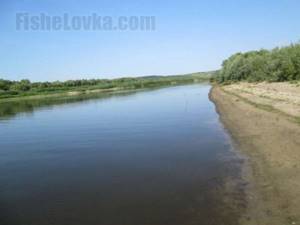
Photo 1. A promising place for catching ruff.
What does the ruff bite on?
Considering that the ruff is a common catch when fishing for roach or bream, then for targeted fishing you don’t have to think about what the ruff bites on in open water or when fishing from ice.
Traditional baits are attached to the hook:
- Bloodworm;
- Maggot;
- Worm;
- Burdock larva;
- Caddisfly larva.
When fishing vertically, winter jigs with bait are successfully used.
Along with baits, you can combine different plant fishing baits.
Ruff catching technique
The bite of the ruffe is characterized by the rapid removal of the float under the water. When fishing with a nodding rod, it is also impossible to miss a bite. It is important to perform timely cutting. But this doesn’t always work. More often the ruff swallows the bait very deeply. In most cases, even if desired, it is not possible to leave the fish alive.
It should be noted that the bite of a small ruff is similar to the capture of bait by a large fish. We must pay tribute to the worthy resistance when playing. This fish should not be considered a “weed”. If its use is not possible, then it is better to release the ruff into its native element.
Where does the ruffe live and what does it eat?
Searching for fish in rivers, ponds, lakes and reservoirs should begin in flowing and relatively deep areas (1-5 m) with a sandy-clay or gravel bottom. It is important to take into account that small perch are a favorite delicacy of active predators (burbot, catfish, bersh, pike, pike perch), so they try to stick to natural shelters in stones, vegetation, bushes, snags, and driftwood.
Promising places are those that are cooled by underwater springs or that are shaded most of the day by steep banks, tree branches, artificial structures, tall or floating plants (susak, reeds, cattails, water lilies). This is explained by the fact that the fish leads a twilight lifestyle and is well oriented in dimly lit water. In spring, summer and the warm months of autumn, the main feeding activity occurs in the early morning, late evening and night. On cloudy days and the cold season, the search for food continues almost around the clock; this is the optimal time for catching ruff. The diet is based on benthic organisms, leeches, small crustaceans, worms, eggs of other fish, and insect larvae. When the species reaches average size, a small number of tadpoles and fry of other fish are added to the menu.
To learn more:
Ide: description of fish, habitat and lifestyle
But the ruffe cannot be called a predator - it is a pronounced omnivorous benthophage, which has fierce food competition not with pike perch or pike, but with roach, crucian carp, bream, and gudgeon. That is why an increase in the number of “prickly” fish in a reservoir leads to a decrease in the growth rate of many cyprinids.
Lifestyle and living conditions of fish.
The ruffe is very unpretentious, tolerates water temperatures from 2 to 35 C˚, spawns at 4-18 C˚, the range of natural conditions under which it lives and reproduces is quite large. Despite this, the ruffe prefers clean and cool water, sandy or rocky bottom, but can perfectly adapt to clay, silt and shell soil.
Like all perches, it lives in schools, does not tolerate sunlight and heavily silted soil, and tries to avoid such places. Lives in calm rivers and lake-type flowing reservoirs, spring ponds, quarries, and reservoirs. In reservoirs it selects areas with slow currents. It tolerates brackish water well with a salt content of up to 11‰, similar to the Sea of Azov, therefore it calmly settles in the seaside, sea bays and river deltas, and is numerous in the Gulf of Finland. Does not live in fast-flowing mountain rivers and small spring streams.
Lures and fishing
Ruffs are caught all year round using a float rod and strong fishing line. Baits are mainly used live:
- maggot;
- bloodworm;
- earthworm or dungworm;
- caddisfly;
- bark beetle larva;
- burdock moth.
The float chosen is light, with a high antenna, in order to quickly react to a sharp bite. If you are late with the hook, the fish may swallow the hook with the bait deep into its throat, and it will be problematic to pull it out. Do not use small hooks with a short shank. https://youtube.com/watch?v=Aq7ktKG5GYs In winter, fish are well caught using nodding gear with a small jig, on which bloodworms or maggots are attached. In winter, ruffs can be fed with chopped earthworms.
The best time for fishing is morning and evening hours.
Geography of ruffe distribution.
The natural habitat of the ruffe (in the text there is an abbreviation - Er. *) is huge, extending from the central part of France to the system of rivers and lakes of the river. Kolyma, flowing in North-Eastern Siberia. Covers waterways and reservoirs of the Baltic Sea basin, all of Central and Eastern Europe, the Asian part of Russia, the Urals, Siberia, and the Far East. In the northern hemisphere, the habitat of the ruffe borders almost on the shores of the Arctic Ocean; the southern borders cover Kazakhstan.
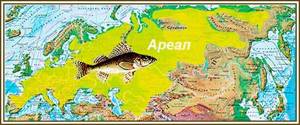
People helped the ruffe get into some countries; they accidentally brought it along with ballast water. Thus he ended up in Ireland and the USA.
Features of character and lifestyle
Photo: Ruff in Russia
Ruff loves cool water. When the water in a pond becomes too warm, it goes to the mouth of streams or hides under bogs. There he can wait out the whole summer if he lives in a shallow body of water. There lives another one who is not a fan of warm water - the jig, which becomes the main food for the ruffe at this time. If possible, in the summer it can go out of the lakes into the river bed and go there to the next dam, where it then finds the deepest pool in order to wait out the summer at its bottom.
If necessary, the ruffe can also live in places with fast currents. But, like a lot of other bottom-dwelling fish, there he tries to take a liking to some kind of snag, a large stone, a ledge in order to hide behind it and feel comfortable in such a secluded place. In general, ruffes are quite peaceful fish. They get along well with each other within the same population. Even if ruffs of different ages and sizes live in the same place, they do not conflict with each other and do not compete. But at the same time, in the habitat of the ruff population, except for burbot, rarely can anyone get along. Do not forget that ruffs are still predators.
Ruffs usually do not like to change their habitat. In general, they are not characterized by migration. They do this exclusively under compulsion, when the water warms up to a critical level. In this case, the ruffes move to other areas in search of cooler currents. When summer passes and autumn comes, the ruffes begin to actively group, choosing a habitat with a sufficient amount of food. By the way, it is at this time that they become easy prey, so the main catch for ruffs occurs in mid-autumn.
Interesting fact: Larger fish go to the bottom of pools for the winter earlier than young fish.
Early departure to depth is a necessary measure. It happens that strong winds throw ruffs onto land that did not have time to move from shallow water to depth.
Population and species status
Photo: What a ruff looks like
Today it is extremely difficult to estimate the exact size of the ruffe population in nature. The reason is that they inhabit too many bodies of water. It is difficult to even imagine in which of them how many individuals of these fish can live. This is why it is impossible to accurately calculate the population size in nature.
At the same time, we can say with confidence that the status of the population is very disappointing. Ruffs belong to a category of fish whose numbers are rapidly declining and therefore require active protection from government agencies.
Ruffs are popular as a fishing object. However, these fish are not bred on farms under artificial conditions. Only individuals caught in natural conditions are consumed for food. That is why their numbers are declining at such a rapid pace. In addition, in natural conditions they also face a lot of dangers, which is precisely what this situation is connected with.
If no measures are taken, soon many subspecies or even the species of ruffs as a whole will simply disappear. But if the number of fish caught can be at least slightly regulated at the legislative level, limiting this issue, then nothing can be done against the natural enemies of these fish.
